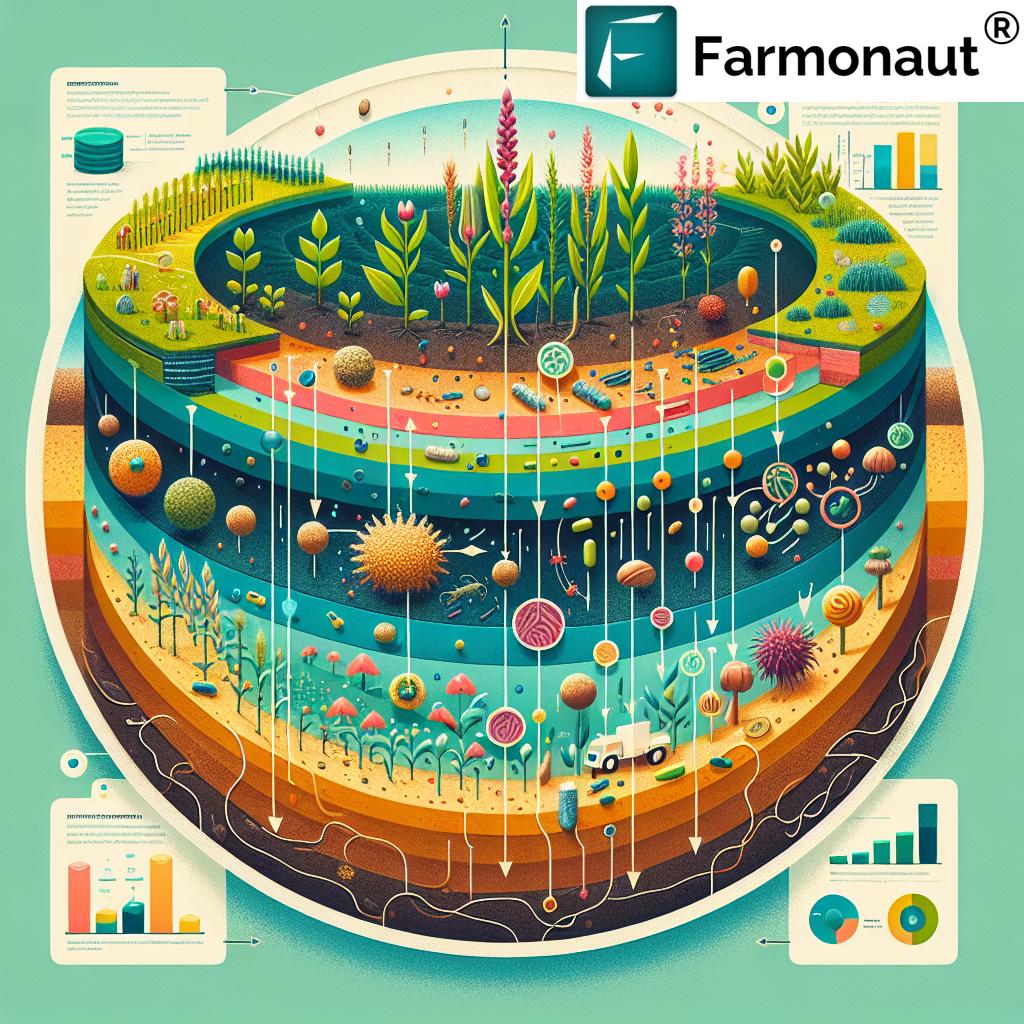Unlocking Soil Secrets: How Crop Rotations Boost Microbial Diversity and Farm Productivity in Alberta

“Mycorrhizal fungi can increase nutrient absorption in crops by up to 400%, enhancing overall plant health and yield.”
Welcome to our deep dive into the fascinating world of soil health management and sustainable farming practices in Alberta. As we embark on this journey, we’ll uncover the hidden secrets beneath our feet that hold the key to agricultural success. Our focus? The powerful impact of crop rotations on soil microbial diversity and farm productivity.
In today’s blog post, we’ll explore how diverse crop rotations influence the intricate ecosystem of soil microbes, enhancing nutrient cycling and overall soil health. We’ll delve into cutting-edge research on plant-microbe interactions and reveal how different crops affect soil populations, from bacteria to fungi. By the end of this article, you’ll gain valuable insights into precision agriculture technology and its applications in optimizing soil ecosystem services.
Whether you’re a farmer, agronomist, or simply curious about the future of agriculture, this blog will provide you with a comprehensive understanding of how tillage, fertilizer use, and crop selection influence soil microbes. Let’s embrace the future of agriculture together and unlock the potential for improved crop yields and sustainable farming practices.
The Soil Ecosystem: A Hidden World Beneath Our Feet
To truly appreciate the importance of crop rotations, we must first understand the complex ecosystem that exists within our soil. This hidden world is teeming with life, from microscopic bacteria to intricate fungal networks, all playing crucial roles in maintaining soil health and supporting plant growth.
- Bacteria: These single-celled organisms are the most abundant microbes in soil. They break down organic matter, fix nitrogen, and contribute to nutrient cycling.
- Fungi: Including mycorrhizal fungi, these organisms form symbiotic relationships with plant roots, enhancing nutrient uptake and improving soil structure.
- Protozoa: These single-celled organisms feed on bacteria and help release nutrients for plant use.
- Nematodes: While some are plant pests, many nematodes are beneficial, feeding on bacteria and fungi and contributing to nutrient cycling.
- Arthropods: Larger organisms like mites and springtails help break down organic matter and improve soil structure.
This diverse community of soil microbes forms the foundation of a healthy agricultural ecosystem. By understanding and nurturing this hidden world, we can unlock the full potential of our farmlands.
Crop Rotations: A Key to Unlocking Soil Potential
Crop rotation is a fundamental practice in sustainable agriculture, involving the systematic planting of different crops in a sequence over several growing seasons. This approach offers numerous benefits for soil health and farm productivity:
- Improved soil structure and fertility
- Enhanced pest and disease control
- Increased biodiversity
- Better water management
- Reduced reliance on synthetic inputs
In Alberta, where agriculture plays a vital role in the economy, implementing effective crop rotations is crucial for maintaining long-term soil health and productivity. Let’s explore how different rotation strategies can impact soil microbial diversity and overall farm productivity.
Comparing Crop Rotation Strategies
| Crop Rotation Strategy | Soil Microbial Diversity Index | Nutrient Cycling Efficiency (%) | Mycorrhizal Fungi Colonization (%) | Crop Yield Increase (%) | Soil Organic Matter Content (%) | Fertilizer Use Reduction (%) |
|---|---|---|---|---|---|---|
| Continuous Monoculture | Low (1.2) | 40 | 10 | 0 | 2.0 | 0 |
| Two-Year Rotation (e.g., Wheat-Canola) | Medium (2.5) | 60 | 30 | 10 | 2.5 | 15 |
| Three-Year Rotation (e.g., Wheat-Canola-Peas) | High (3.8) | 75 | 50 | 20 | 3.0 | 25 |
| Four-Year Rotation (e.g., Wheat-Canola-Peas-Barley) | Very High (4.5) | 85 | 65 | 30 | 3.5 | 35 |
| Diverse Rotation with Cover Crops | Excellent (5.0) | 95 | 80 | 40 | 4.0 | 50 |
This table clearly demonstrates the benefits of implementing diverse crop rotations. As we move from continuous monoculture to more diverse rotations, we see significant improvements across all metrics. Let’s break down these benefits in more detail.
The Impact of Crop Rotations on Soil Microbial Diversity
“Diverse crop rotations can boost soil microbial diversity by 20-30%, leading to improved nutrient cycling and soil health.”
One of the most significant benefits of crop rotations is their positive impact on soil microbial diversity. Each crop type has unique root exudates and residues that support different microbial communities. By rotating crops, we create a more diverse habitat for soil microbes, leading to a more robust and resilient soil ecosystem.
Bacterial Diversity
Crop rotations significantly influence bacterial populations in the soil. Different crops support various bacterial species, each with unique roles in nutrient cycling and soil health. For example:
- Legumes (e.g., peas, soybeans) promote nitrogen-fixing bacteria, enhancing soil nitrogen content.
- Cereals (e.g., wheat, oats) support bacteria that break down complex carbohydrates, improving soil structure.
- Brassicas (e.g., canola) encourage bacteria that suppress soil-borne pathogens.
By incorporating a variety of crops in rotation, we create a more balanced and diverse bacterial community, enhancing overall soil health and fertility.
Fungal Networks and Mycorrhizae
Crop rotations also play a crucial role in supporting diverse fungal communities, particularly mycorrhizal fungi. These beneficial fungi form symbiotic relationships with plant roots, enhancing nutrient uptake and improving soil structure. Different crop types support various mycorrhizal species, leading to a more robust fungal network when rotations are implemented.
For example, research has shown that incorporating flax into rotations can significantly increase mycorrhizal colonization in subsequent crops. This is because flax is highly dependent on mycorrhizal associations, leading to a more developed fungal network in the soil.
At Farmonaut, we understand the importance of soil health and microbial diversity in sustainable agriculture. Our satellite-based crop health monitoring system can help farmers track the impact of their crop rotation strategies on overall field health. By providing real-time data on vegetation health (NDVI) and soil moisture levels, we empower farmers to make informed decisions about their rotation practices.
Nutrient Cycling and Crop Rotations
One of the most significant benefits of diverse crop rotations is improved nutrient cycling efficiency. As different crops have varying nutrient requirements and root structures, they interact with soil nutrients in unique ways. This diversity helps to maintain a balanced nutrient profile in the soil and reduces the risk of nutrient depletion.
Nitrogen Fixation and Cycling
Incorporating legumes like peas or soybeans into crop rotations is an excellent way to improve nitrogen cycling in the soil. These crops form symbiotic relationships with nitrogen-fixing bacteria, converting atmospheric nitrogen into plant-available forms. This natural process can significantly reduce the need for synthetic nitrogen fertilizers in subsequent crops.
Phosphorus and Potassium Management
Different crops have varying abilities to access and utilize soil phosphorus and potassium. For example, canola is known for its deep root system, which can access nutrients from lower soil layers. When rotated with shallow-rooted crops like cereals, this can lead to a more efficient use of soil nutrients throughout the soil profile.
By implementing diverse crop rotations, farmers can optimize nutrient use efficiency and reduce reliance on synthetic fertilizers. This not only improves farm profitability but also contributes to more sustainable agricultural practices.
The Role of Precision Agriculture in Optimizing Crop Rotations
As we delve deeper into the benefits of crop rotations, it’s essential to recognize the role that precision agriculture technology plays in optimizing these practices. At Farmonaut, we’re at the forefront of this agricultural revolution, providing farmers with the tools they need to make data-driven decisions about their crop rotations and soil management strategies.
Satellite-Based Crop Monitoring
Our satellite-based crop health monitoring system allows farmers to track the impact of their crop rotation strategies in real-time. By analyzing multispectral satellite images, we provide valuable insights into:
- Vegetation health (NDVI)
- Soil moisture levels
- Crop stress indicators
- Field variability
This data enables farmers to identify areas where crop rotations may need adjustment or where soil health issues may be emerging. By addressing these issues promptly, farmers can optimize their rotation strategies for maximum soil health and productivity.
Explore Farmonaut’s API for advanced data integration
AI-Powered Crop Rotation Recommendations
Our Jeevn AI Advisory System takes precision agriculture to the next level by providing personalized crop rotation recommendations based on historical field data, soil type, and local climate conditions. This AI-driven tool helps farmers:
- Optimize crop sequences for maximum soil health benefits
- Predict potential pest and disease pressures
- Balance nutrient requirements across rotation cycles
- Identify opportunities for cover crop integration
By leveraging artificial intelligence and machine learning, we’re helping farmers make more informed decisions about their crop rotations, leading to improved soil health and farm productivity.
The Impact of Tillage on Soil Microbial Communities
While crop rotations play a crucial role in promoting soil microbial diversity, it’s important to consider the impact of tillage practices on these delicate ecosystems. Tillage can have both positive and negative effects on soil microbes, depending on its intensity and frequency.
Conservation Tillage and No-Till Systems
Conservation tillage and no-till systems have gained popularity in recent years due to their potential to preserve soil structure and promote microbial diversity. These approaches offer several benefits:
- Increased soil organic matter retention
- Improved soil structure and water infiltration
- Enhanced habitat for beneficial soil organisms
- Reduced soil erosion and compaction
By minimizing soil disturbance, these practices allow for the development of more stable and diverse microbial communities. This, in turn, can lead to improved nutrient cycling and overall soil health.
Balancing Tillage and Crop Rotations
While conservation tillage offers many benefits, it’s essential to balance this approach with effective crop rotations. Some key considerations include:
- Adapting rotation sequences to manage crop residues effectively
- Incorporating cover crops to maintain soil cover in no-till systems
- Using strategic tillage when necessary to address specific soil health issues
By combining thoughtful tillage practices with diverse crop rotations, farmers can create optimal conditions for soil microbial communities to thrive.
The Role of Cover Crops in Enhancing Soil Microbial Diversity
Cover crops play a vital role in maintaining and enhancing soil microbial diversity, especially when integrated into crop rotation strategies. These non-harvested crops, planted between main crop seasons, offer numerous benefits to soil health and microbial communities.
Benefits of Cover Crops
- Year-round root exudates: Provide a continuous food source for soil microbes
- Increased organic matter: Enhance soil structure and water retention
- Nutrient cycling: Capture and recycle nutrients, reducing leaching
- Erosion control: Protect soil from wind and water erosion
- Weed suppression: Compete with weeds, reducing herbicide use
By incorporating cover crops into rotation plans, farmers can significantly boost soil microbial diversity and activity, leading to more resilient and productive agricultural systems.
Crop Rotation Strategies for Alberta’s Unique Climate
Alberta’s diverse climate, ranging from prairie grasslands to parkland and boreal regions, presents unique challenges and opportunities for crop rotations. Let’s explore some effective rotation strategies tailored to Alberta’s agricultural landscape:
Prairie Region Rotations
In the drier prairie regions of southern Alberta, water conservation is crucial. Effective rotation strategies might include:
- Wheat – Canola – Pulse (e.g., lentils or peas) – Fallow: This four-year rotation balances water use, improves soil nitrogen through pulses, and allows for moisture recharge during the fallow year.
- Wheat – Canola – Barley – Pulse: A continuous cropping system that maintains soil cover and diversifies root depths.
Parkland Region Rotations
In the more humid parkland regions, rotations can be more diverse:
- Canola – Wheat – Barley – Peas – Oats: This five-year rotation maximizes crop diversity and balances nutrient demands.
- Wheat – Canola – Peas – Barley – Flax: Incorporates flax to promote mycorrhizal fungi development.
Integrating Forage Crops
For farmers with livestock or those looking to improve soil health on marginal land, integrating forage crops can be beneficial:
- Barley (silage) – Alfalfa (3 years) – Canola – Wheat: This rotation improves soil structure and provides feed for livestock.
By tailoring crop rotations to local conditions and incorporating a diverse range of crops, Alberta farmers can maximize the benefits of rotation while addressing regional challenges.

The Future of Crop Rotations: Precision Agriculture and Big Data
As we look to the future of agriculture, the integration of precision farming techniques and big data analytics promises to revolutionize crop rotation strategies. At Farmonaut, we’re at the forefront of this agricultural revolution, providing farmers with cutting-edge tools to optimize their rotation practices.
Data-Driven Rotation Planning
Our advanced satellite-based monitoring system collects vast amounts of data on crop health, soil moisture, and field variability. By analyzing this data over multiple growing seasons, we can help farmers:
- Identify optimal crop sequences based on field-specific conditions
- Predict potential yield gains from different rotation strategies
- Optimize resource allocation across rotation cycles
- Monitor the long-term impact of rotations on soil health
Explore our API Developer Docs for advanced integration options
AI-Powered Recommendations
Our Jeevn AI Advisory System takes crop rotation planning to the next level by providing personalized recommendations based on:
- Historical field data
- Local climate patterns
- Market trends and commodity prices
- Soil health indicators
This AI-driven approach allows farmers to make more informed decisions about their rotation strategies, balancing short-term profitability with long-term soil health goals.
Conclusion: Embracing the Power of Crop Rotations
As we’ve explored throughout this blog post, crop rotations are a powerful tool for boosting soil microbial diversity and farm productivity in Alberta. By implementing diverse rotation strategies, farmers can:
- Enhance soil health and fertility
- Improve nutrient cycling efficiency
- Reduce reliance on synthetic inputs
- Increase crop yields and overall farm productivity
- Promote more sustainable and resilient agricultural systems
At Farmonaut, we’re committed to supporting farmers in their journey towards more sustainable and productive agriculture. Our advanced satellite-based monitoring system, AI-powered advisory tools, and data-driven insights empower farmers to make informed decisions about their crop rotations and soil management practices.
By embracing the power of crop rotations and leveraging cutting-edge technology, we can work together to build a more sustainable and productive future for agriculture in Alberta and beyond.
FAQs
- What is the ideal crop rotation length for maximizing soil health?
The ideal rotation length can vary depending on local conditions, but generally, longer rotations (3-5 years) with diverse crops tend to provide the greatest benefits for soil health and microbial diversity. - How can I incorporate cover crops into my rotation in Alberta’s short growing season?
Consider using fast-growing cover crops like oats, barley, or winter rye that can establish quickly after harvest. Alternatively, undersowing cover crops into standing main crops can extend the growing window. - What are some signs that my crop rotation is improving soil health?
Indicators of improved soil health include increased organic matter content, better water infiltration, improved soil structure, and higher earthworm populations. You may also notice reduced pest and disease pressure over time. - How can Farmonaut’s technology help me optimize my crop rotations?
Farmonaut’s satellite-based monitoring system provides real-time data on crop health and field variability, allowing you to track the impact of your rotations over time. Our AI-powered advisory system can also provide personalized recommendations for optimizing your rotation strategies based on your specific field conditions and goals. - Are there any crops that should be avoided in rotations due to negative impacts on soil microbes?
While most crops can be beneficial in rotations, some crops like canola can have temporary negative effects on certain beneficial fungi. However, these effects are usually short-lived and can be mitigated by incorporating diverse crops in the rotation.






